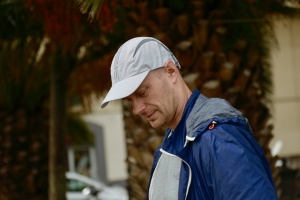Laboratory of Stem Cell Biology:4
The main feature of this group is a numerous fields of scientific interest.
We worked with regulation of dopamine receptors in freshwater pond snail Lymnaea and found that at condition of transient oxidant stress the molecular machine of dopamine signalization invert the signaling globally due to changing of D1-like receptor abilities to activate the corresponded G-proteins. This situation realized at conditions of diving of animals and physiological oxidant stress. At diving the part of dopamine signaling is stopped. The neurons that are the part of breath –generating neural net are in off-form at this moment and breathing net is not working. The mechanism of abortish signaling is in the stopping of GDP-GTP exchange due to oxidation of the critical SH-residues of G alpha proteins.
During the examination of the P2X receptors in the neurons of dorsal ganglions we with colleagues found that these pain receptors are strongly inhibited by opiates.
Detailed investigation of the neutral proteases activities in embryonal, newborn and adult brains led us to the understanding that most of current methods do not allow to discriminate transient and very rare in cellular life caspase activities in contrast to proteasomal caspase-like activities, which is numerous.
Further investigations in this field made the possibility to found appearance of active forms of caspase in the cultures of mesenchymal, hematopoietic and non- hematopoietic stem cells that can be obtained in the samples of adult human bone marrow. The careful analysis of cultivation conditions allowed us to use the circumstances that were optimal for long-terms experiments at xenotransplantation. Using the model of subtotal radiological lesion of experimental rats we found that human mesenchymal stem cells can revive the functional abilities of vessel endothelium cells that were damaged by radiation. We could not find the footprints of donor cells in the vessels of recipients and proposed that this influence has a endocrine or paracrine character. More detailed these experiment can be described in following manner.The effect of intravenous administration of human mesenchymal stromal stem cells (hMSC) has been evaluated by means of large-conductance calcium-dependent potassium channel (BKCa) activity measurements in thoracic aorta smooth muscle cells (SMC) obtained from non-fatal whole-body irradiated rats, using the patch clamp technique in whole-cell modification, and the standard acetylcholine (ACh) test to evaluate functional endothelium integrity using SM contractile recordings. Myofilament calcium sensitivity was estimated using simultaneous contractile recordings versus [Ca2+]i. Arterial blood was measured in intact and irradiated rats before and after hMSC administration. Stimulation of isolated SMC from the control group of animals with depolarizing voltage steps showed that outward K+ currents sensitive to the BKCa inhibitor paxilline were expressed. Outward currents in SMC obtained from irradiated animals were significantly reduced on the 30th day of post-irradiation. Irradiation led to a significant elevation in arterial blood pressure and reduced ACh-induced relaxation responses in irradiated rats as compared with the control group. Simultaneous measurements of contractile force and [Ca2+]i showed that myofilament Ca2+ sensitivity had increased following irradiation. Intravenously injected hMSC effectively restored BKCa current and the amplitude of ACh-induced endothelium-dependent vasodilatation in vascular tissues obtained from post-irradiated rats. SMC obtained from irradiated rats treated with hMSC demonstrated a significantly increased paxilline-sensitive component of outward potassium currents, indicating that BKCa activity had been restored. hMSC administration normalized increased blood pressure and myofilament Ca2+ sensitivity in irradiated animals. When administered to healthy rats, hMSC were without effects on either of these. This study does not provide any immunohistochemical proof of hMSC engraftment in the host rats. PCR analysis showed that hMSCs were negative for hematopoietic cell markers and positive for hMSC markers. There were no clinical signs of graft-versus-host disease throughout the experimental period of 30 days. The data obtained suggest that hMSC demonstrate a clearly expressed ability to normalize vascular function damaged following irradiation, i.e. to reduce an elevated arterial blood pressure and myofilament Ca2+ sensitivity, and to repair BKCa function and endothelium-dependent relaxation in vascular tissues obtained from irradiated animals. Thus, hMSC seem to be worthwhile therapeutic approach in cases of ionizing irradiation accident or radiation beam therapy. The similar observations were done at the case of investigation of another patological models – genetically-determined arterial hypertension and diabetes mellitus. Thus, the physiological experiments at investigations of the mechanisms of stem cells influence at conditions of therapy of different pathological situation or influence led us to the global understanding of mechanisms of vitality influence of stem cells use. Of course, we understood that such influence cannot be magic J and we continue our investigations in this field using preparations of exosomes – vesicles that are generated by stem cells (and not only stem cells) at endocytosis in cultural conditions also.
The principal articles.
- I Chizhmakov, Y Yudin, N Mamenko, I Prudnikov, Z Tamarova, O Krishtal Opioids inhibit purinergic nociceptors in the sensory neurons and fibres of rat via a G protein-dependent mechanism. Neuropharmacology, 2005, v.48 (5), P. 639-647
- A Soloviev, I Prudnikov, V Tsyvkin, S Tishkin, S Kyrychenko, S Zelensky, Irina Ivanova. Electrophysiological and contractile evidence of the ability of human mesenchymal stromal cells to correct vascular malfunction in rats after ionizing irradiation. The Journal of Physiological Sciences, 2010, v. 60 (2), P. 161-172
- IM Prudnikov, AN Smirnov. Short peptide tools for monitoring caspase and proteasome activities in embryonal and adult rat brain lysates: an approach for the differential identification of proteases. The Journal of Biochemistry, 2012, v.151 (3), P. 299-316
- IM Prudnikov, VN Tsyvkin. Dependence of the coupling of dopamine receptors to G proteins on the protein redox state in the neural plasma membranes of pond snail. Comparative Biochemistry and Physiology Part B: Biochemistry and Molecular Biology, 2003, V.134 # 2, P. 277-286
- I. V. Ivanova, K. I. Klimenko, I. V. Kizub, I. M. Prudnikov*, V. N. Tsyvkin*, A. I. Soloviev. Human mesenchymal stem cells as a potential therapeutic approach to vessel function recovery in genetically determined arterial hypertension and diabetes mellitus. Journal of Ukrainian Academy of Medical Sciences, 2013, т. 19, № 3


